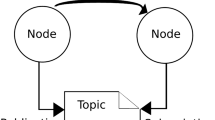Abstract
Non-functional requirement (NFR) conflicts pose a serious threat to any system, especially robotic systems, where identifying conflicts prior to system deployment is crucial and can highly depend on different contexts, in relation to different environmental conditions. The objective of this work is to provide a simulation-based approach for the identification of NFR conflicts in different contexts for such systems. The identified conflicts can help the system designer minimize the impact and avoid failures resulting from the negligence of NFR conflicts. The simulation results are useful to infer and evaluate the different conflicts between NFRs and to study the impact of different contexts on the requirements themselves. The adopted methodology is easily reproducible in different development scenarios.








Similar content being viewed by others
Explore related subjects
Discover the latest articles and news from researchers in related subjects, suggested using machine learning.Notes
References
Baheti R, Gill H (2011) Cyber-physical systems. In: The impact of control technology, vol 12, pp 161–166
Mairiza D, Zowghi D (2010) Constructing a catalogue of conflicts among non-functional requirements. Springer, London, pp 31–44
Roy M et al (2023) Correlating contexts and NFR conflicts from event logs. Softw Syst Model
Sentilles S (2012) Managing extra-functional properties in component-based development of embedded systems. Ph.D. thesis, Mälardalen University, Västerås, Sweden . http://www.es.mdu.se/publications/2563-
Brugali, D (2019) Non-functional requirements in robotic systems: challenges and state of the art. IEEE, pp 743–748
Vicente-Chicote C et al., de Vicente JMF & et al (2019) (eds) Modeling and estimation of non-functional properties: leveraging the power of QOS metrics. In: de Vicente JMF et al (eds) From bioinspired systems and biomedical applications to machine learning—8th international work-conference on the interplay between natural and artificial computation, IWINAC 2019, Almería, Spain, June 3–7, 2019, Vol. 11487 of lecture notes in computer science. Springer, pp 380–388. https://doi.org/10.1007/978-3-030-19651-6_37
Deng Z et al (2023) Safety-aware robotic steering of a flexible endoscope for nasotracheal intubation. Biomed Signal Process Control 82:104504
Thalamy P, Piranda B, Naz A, Bourgeois J (2022) Visiblesim: a behavioral simulation framework for lattice modular robots. Robot Autono Syst 147:103913
Farley A, Wang J, Marshall JA (2022) How to pick a mobile robot simulator: a quantitative comparison of CoppeliaSim, Gazebo, MORSE and Webots with a focus on accuracy of motion. Simul Model Pract Theory 120:102629
Roy M, Deb N, Cortesi A, Chaki R, Chaki N (2021) NFR-aware prioritization of software requirements. Syst Eng 24:158–176
Serral E, Sernani P, Dragoni AF, Dalpiaz F (2017) Contextual requirements prioritization and its application to smart homes. Springer
Dieber B et al (2020) Penetration testing ROS. Stud Comput Intell 831:183–225
White R, Caiazza G, Christensen H, Cortesi A (2019) SROS1: using and developing secure ROS1 systems. Stud Comput Intell 778:373–405
Cysneiros LM, Raffi M, & Sampaio do Prado Leite JC (2018) Software transparency as a key requirement for self-driving cars. pp 382–387
Liu S & Capretz LF (2021) An analysis of testing scenarios for automated driving systems. pp 622–629
Cysneiros LM, Raffi M, & Sampaio do Prado Leite JC (2018) Software transparency as a key requirement for self-driving cars. pp 382–387
Blender T, Schlegel C (2020) Implementing resource adequate service robot behavior by systematic management of non-functional properties: an intralogistics use case. vol 1, pp 659–666
Brugali D (2018) Modeling and analysis of safety requirements in robot navigation with an extension of uml marte. pp 439–444
Samin H (2020) Priority-awareness of non-functional requirements under uncertainty. pp 416–421
Wohlrab R, Meira-góes R, & Vierhauser M (2022) Run-time adaptation of quality attributes for automated planning. pp 98–105
Dosovitskiy A, Ros G, Codevilla F, Lopez A & Koltun V (2017) Carla: an open urban driving simulator. PMLR, pp 1–16
Pages J, Marchionni L, & Ferro F (2016) Tiago: the modular robot that adapts to different research needs. vol 290
Pinciroli C et al (2012) Argos: a modular, parallel, multi-engine simulator for multi-robot systems. Swarm Intell 6:271–295
Anderson J, Anderson R, Anderson T, Bailey C, Harper M (2023) Stealth centric autonomous robot simulator (scars). Softw Impacts 16:100497
Acknowledgements
Work partially supported by SERICS (PE00000014) under the NRRP MUR program funded by the EU - NGEU, iNEST-Interconnected NordEst Innovation Ecosystem funded by PNRR (Mission 4.2, Investment 49 1.5) NextGeneration EU - Project ID: ECS 00000043, and SPIN-2021 “Ressa-Rob” funded by Ca’ Foscari University.
Author information
Authors and Affiliations
Contributions
All authors equally contributed in this work.
Corresponding author
Ethics declarations
Conflict of interest
The authors declare no competing interests.
Additional information
Publisher's Note
Springer Nature remains neutral with regard to jurisdictional claims in published maps and institutional affiliations.
Rights and permissions
Springer Nature or its licensor (e.g. a society or other partner) holds exclusive rights to this article under a publishing agreement with the author(s) or other rightsholder(s); author self-archiving of the accepted manuscript version of this article is solely governed by the terms of such publishing agreement and applicable law.
About this article
Cite this article
Bag, R., Roy, M., Cortesi, A. et al. Eliciting context-oriented NFR constraints and conflicts in robotic systems. Innovations Syst Softw Eng (2023). https://doi.org/10.1007/s11334-023-00545-y
Received:
Accepted:
Published:
DOI: https://doi.org/10.1007/s11334-023-00545-y




